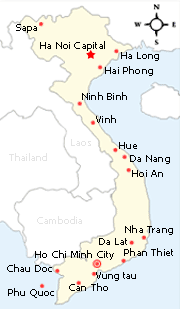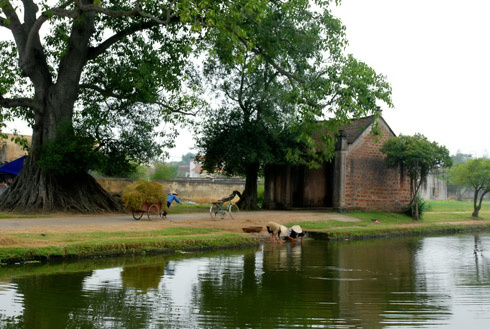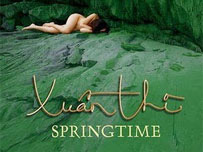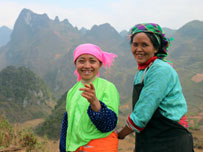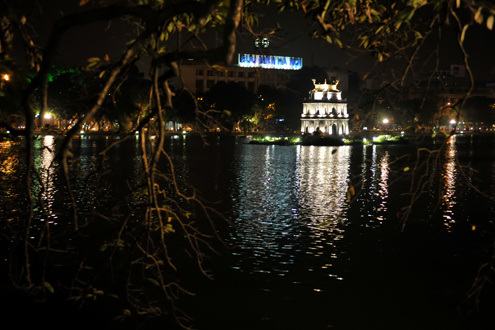Vietnam Culture & PeopleBanyan trees, river wharves, ancient wells, buffaloes and rice fields are special traits of Vietnamese traditional villages. A traditional in VNExpress’ photos.
VietNamNet/VNE Post By: admin
A nude photo collection was deleted from the list for Vietnam Book Awards 2009 Thursday although it was previously mentioned as a gold prize winner.
Thai Phien, author of the Xuan thi (Springtime) collection gathering 71 nude photos, was quoted by newswire Dan Tri as saying, “The name of my book was hidden when the list of awarded books was released to the press on Thursday. I don’t know why.” Phien said that Nguyen Duc Binh, director of Van Nghe (Arts) Publishing House that published the collection, had on Tuesday informed him that an official decision from the Vietnam Publication Association said his book would receive a consolation prize. “A month ago, a member from the Board of Judges who I cannot name told me that Springtime has been chosen for a golden prize. But now it even does not even get a consolation prize.” Nguyen Kiem, chairman of the Vietnam Publication Association, said the judges had given careful consideration before deciding to give Springtime the consolation award for the “Beautiful book” category. “But right after we made the list, we received an objection from the authorities that the collection must not be circulated widely as an association award winner.” Kiem said a book can only be awarded if it doesn’t violate the award rules or receive negative comments from the authorities. He added, however, that the association will continue considering the case until the awarding ceremony that will be held on Sunday at the Temple of Literature in Phien expressed disappointment with the developments, saying “beauty was not valued.” Springtime, comprising selections from 15 years of Phien’s works in nude photography, was published bilingually (Vietnamese and English) in December 2007. The country’s first nude art photo album received a prize from Vietnam Association of Photographic Artists and was chosen by the Voice of While nude photos have been shown occasionally in Vietnamese publications, Confucian traditions are still strong and photographers engaged in the art have had to face social prejudice. There have only been six nude photographers in Vietnam, and one of these was killed several years ago by a model’s fiancé. “I feel like a thief sometimes, taking photographs stealthily with models in a hotel room with ears cocked, apprehensive of someone knocking. Under such pressure, it’s hard to be creative,” Phien said when the book was launched. This year’s “Beautiful book” category will have three gold, seven silver, 15 bronze and 11 consolation awards while the “Best Book” category will have two gold, nine silver, 15 bronze and 11 consolation prizes, the judges said. One book will receive a special award. This year, the winner of this award is a history book titled 1000 Years of Thang Long Culture and Literature. VietNamNet/Thanh Nien Post By: admin
They grow their crops on the rocks and walk several kilometers of steep, cold mountain roads to buy and sell small goods, but the Mong families on the Dong Van Plateau are some of the most hospitable in the world. After the long journey, settling into the silence and peace of a stop high mountain road in Ha Giang Province can be an arresting experience. Vietnam’s northernmost province is located in the northwestern. Hoang Lien Mountains – the Tonkinese Alps as the French called them – near the border with China. All’s quiet except for the whisper of the crisp breeze and the crunch of a local Mong family’s sandals on the road as they walk carrying large bamboo backpacks filled whatever produce or goods they’ve either just bought or are about to sell at the market. The language barrier keeps us at a distance in one way, but the simple smiles of the family bring our two very different worlds close together. Mesmerized by the strength and spirit in their faces, the natural beauty that surrounds us – limestone peaks creeping above a dense mist, vibrant green valleys descending into earth-red rivers – is equally enchanting. I’ve never met anyone who came here and didn’t want to come back. The sturdy roads on the steep sides of the Dong Van Highlands tower above green corn fields in the summer and colorful valleys of wild flowers in the autumn and spring. The carpet of colors – even on grey, overcast and otherwise dreary days – is breathtaking. Life in the slow lane The journey to Dong Van is not exactly easy, but it’s worth it. At an altitude of more than 1,000 meters above sea level, the bends are sharp and the passes narrow for hours along the rocky plateau. Drive slow, especially if you go by motorbike, as the safety rails are not very high. The motorbike is the most intense way to experience the trip, but most rides in Ha Giang are not only gorgeous, but also tiring and at times dangerous. There is only one road connecting the town of Ha Giang to the smaller towns of Quan Ba and Yen Minh and then Dong Van and Meo Vac districts, the most remote part of the trip. From Quan Ba, a beautiful road takes you on cliffs beside the Mien River. The road goes through several Mong villages before it lands in Dong Van Town, where the local Tay community has been living for around 200 years. The French army landed here in the 19th century and there are still several rows of old French tile-roofed homes alongside other Vietnamese homes from the late 19th and early 20th centuries. The Mong market is open every Sunday, producing a variety of different sounds and smells. About 20km from Dong Van is Meo Vac Town, the capital of Meo Vac District. Meo Vac is famous for its “Cow Market” where 300-400 cattle are sold every Sunday in northern Vietnam’s largest bovine exchange. The sellers, who can earn tens of millions of dong per animal, always invite the buyers to enjoy local wine after the transactions. Meo Vac is near Dong Van, so some people go to both markets on a Sunday morning. Happy trails The road between Meo Vac and Dong Van may be one of the most beautiful in Vietnam. But it has a sad history. For years in the 50s and 60s, tens of thousands of migrant laborers from six surrounding provinces worked to break the mountain and build the road. But due to wartime deprivation, many died of diseases and accidents. Now the road is known locally as the “Happy” road, perhaps for its beauty. But there is a monument commemorating the dead workers who built it. The Dong Van Plateau is made even more beautiful by the Mong people who live there. Life can be difficult for a poor Mong family, but in my years of visiting Ha Giang, I’ve never heard anyone complain or ask for a favor. The Mong always smile and are extremely friendly to visitors. All the intricacies and grace of the Dong Van Highlands can hardly even be mentioned in this story alone. More stories will soon follow to elaborate on the culture, history and natural wonder of the area. REACHING FOR RECOGNITION The Dong Van Highlands, encompassing total area of more than 574 square kilometers in Ha Giang Province’s Quan Ba, Yen Minh, Dong Van and Meo Vac districts, could eventually be recognized as a UNESCO Global Geological Park. UNESCO Vietnam has sent an application based on a recent study which concluded that limestone can be found in 11 layers on 80 percent of the surface of the plateau. Two of the layers are sediment dating from 400 to 600 million years ago. How to get there The highlands are about 450km north of Hanoi. Visitors can take National Road 2 by motorbike or ride in cars with fewer than 30 seats. A tour from Hanoi to the plateau should take four days and three nights. There are basically-equipped hotels in Ha Giang, Dong Van and Meo Vac. Hotel rooms are less than VND200,000 (US$10.94) per night. All towns have restaurants, gas stations, mobile phone and Internet services. VNN/Thanh Nien Post By: admin
Streets in darkness, light in small windows, cleaners working on the street… Hanoi’s winter nights are very quiet and romantic.
VietNamNet/VNE Post By: admin
The Hai Van tunnel, linking Thua Thien-Hue and Danang, is the longest road tunnel in Southeast Asia. Let’s discover it in our photos.
VietNamNet/VNE Post By: admin
|

